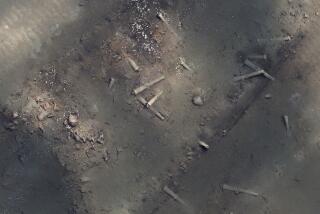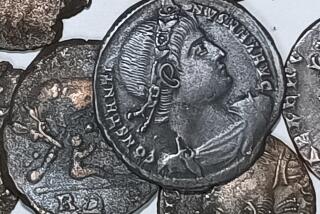Sunken Ship Yields ‘Eccentric Artifact’ : Archeology: Spanish coin found in Florida waters predates Columbus’ first voyage.
- Share via
PENSACOLA, Fla. — A shipwreck on the bottom of Pensacola Bay has yielded a Spanish coin minted at least 18 years before Christopher Columbus landed in the New World in 1492.
But that doesn’t mean the wrecked galleon is as old, Florida state underwater archeologist Roger Smith says. Other artifacts and the construction of the ship indicate that it sank between 1550 and 1580.
“This ship probably made a number of voyages,” Smith said. “This coin probably doesn’t have to be interpreted as belonging to the people who brought the ship here.”
He said the dime-size, copper and silver alloy coin could have fallen from someone’s pocket on an earlier trip or possibly come aboard with some other material.
“You are liable to find any old thing in the attic of a house or the in the bottom of a ship,” Smith said. “It’s an eccentric artifact. It’s something you wouldn’t expect.”
Experts at the American Numismatic Society identified the coin as a “blanca” minted between 1471 and 1474.
It is the same type found at San Salvador Island in the Bahamas, where Columbus first landed. Fifty-nine blancas also have been found at the town site Columbus established in 1494 in the Dominican Republic on the island of Hispaniola.
Smith said blancas remained in circulation at least until 1535 in the Americas, but would have been rare by the time the ship probably sank.
Field director Jim Spirek of the state’s Pensacola Shipwreck Survey found the coin this spring while excavating the stern of the vessel in 10 feet of water.
“It’s a very small coin . . . a piece of pocket change,” Smith said. “It was so fragile that we wondered how it could be cleaned without totally destroying it.”
Conservator John Bratten placed it in a chemical solution for two weeks at the Shipwreck Survey’s laboratory, then removed an encrustation that provides a mirror-image of one side. The encrustation is more detailed than the coin itself, which is badly corroded.
Those details include the image of a leaping lion, a castle, the cross of Jerusalem, an inscription about Christ ruling, and part of the name Enrique IV, king of Castile and Leon in Spain. Enrique was succeeded by his half-sister, Isabella, who married King Ferdinand and sent Columbus to the New World in 1492.
It is the first dated object among nearly 1,500 artifacts recovered from the wreck since it was found nearly three years ago. Other finds include a breast plate, nails, an anchor, a carved wooden silhouette of a galleon and Aztec pottery.
Smith said he suspects that the wrecked ship, at least 78 feet in length, was part of a fleet that brought the first European colonists to what is now the United States in 1559 under Tristan de Luna. Shortly after the Spanish expedition arrived, a hurricane sank six of its ships and beached a seventh. The colony was abandoned after two years.
About 15% of the wreck was excavated before it recently was reburied to preserve it after the state cut off funding for the work. State dollars will be sought again next year.
More to Read
Sign up for Essential California
The most important California stories and recommendations in your inbox every morning.
You may occasionally receive promotional content from the Los Angeles Times.













